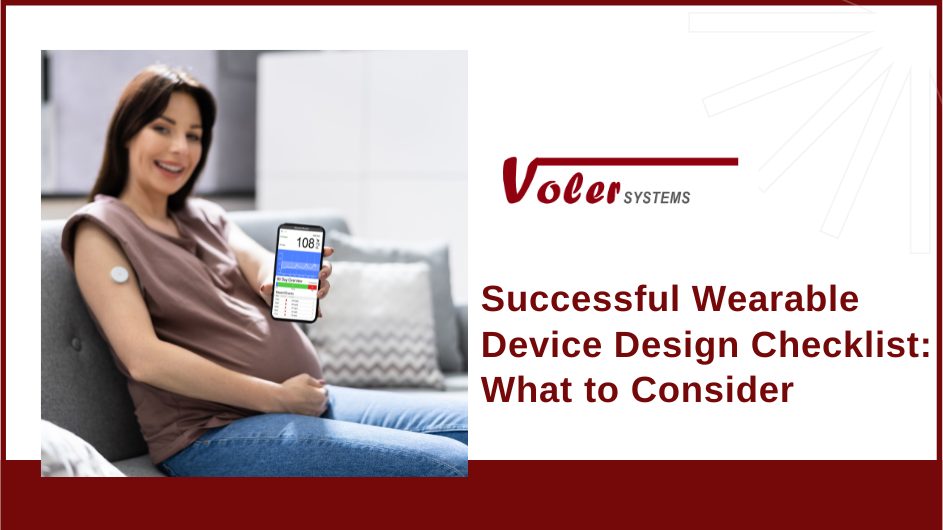The wearable device market is stronger than ever. Innovations continue to push the boundaries of what this technology can do. From consumer electronics that awe to medical devices poised to continue shaping healthcare, there's plenty of room to throw your hat into the ring.
But what makes an exemplary wearable device design?
These devices are complex. They bridge the gap between technology and the human experience, offering a seamless experience that can change a user's life in many ways. A successful design strikes a delicate balance between breathtaking design, impeccable performance, and reliable power efficiency. To get there, designing a device often involves careful strategy and strategic tradeoffs.
It doesn't matter what type of wearable you're creating. Use the following checklist to guide your design process and develop plans for a product you’re proud to bring into this flourishing market.
Power Considerations
Battery life is one of the most important factors to consider in your design. It impacts every other detail, influencing usability and performance. Developing a modern wearable is like a masterclass in low-power design, pushing the limits of what's possible without sacrificing functionality.
- What battery capacity does the device need?
- How much space can the battery take?
- What is the peak current draw?
- What parts require consistent power?
- How often do individual components need to be on?
- What components can be turned off to save power?
- How efficiently does the battery charge and discharge?
- What's the appropriate lifespan of the battery?
- Will the device use a removable or rechargeable battery?
- How will the user charge the battery: Wirelessly or through a physical plug?

Wireless Connectivity
Wireless technology has revolutionized the way we communicate, and it's what makes wearables even possible. The biggest draw of a wearable is that you can use them untethered, requiring careful implementation of wireless transmitters and receivers.
- What type of wireless transmission is appropriate?
- How far does data need to travel?
- How much power does wireless transmission use?
- What are the impacts of wireless technology on battery size, capacity, and lifespan?
- Will the device connect to any gateways?
- Will the device connect to the internet directly?
- What types of antennae do wireless communications require?
- How big does the antenna need to be?
- How often will wireless communications need to run?

Sensors
Sensors are responsible for gathering data. They play a critical role in the functionality and overall performance of the device. The types of sensors you use and how you implement them could make or break your wearable.
- What types of sensors are appropriate for your device?
- Where will you place the sensors in the device?
- What parts of the body need to contact the sensors?
- How does sensor size affect wearability?
- What is the appropriate tradeoff between cost and accuracy?
- What level of accuracy and sensitivity is required?
- Is calibration necessary?
- How will the device test and calibrate sensors?
- What types of conditioning will the sensors need before processing?
- How often do the sensors need to power on?
- How will the sensors affect battery life?
- Will you use contact or non-contact sensors?
- Are the required sensors invasive or non-invasive?
Data Processing and Display
Gathering data is only one piece of the puzzle. You must also plan how the device intends to process, use, and display that information.
- Will the device have onboard processing?
- How will onboard microprocessors affect energy efficiency?
- Can the device benefit from cloud computing?
- Will the wearable have a built-in display or light indicator?
- How often does the device need to process data?
- How do those processes affect battery life and usability?
- How will users interact with the data?
Flexible Circuitry
Wearables should accommodate the user's movements and daily activities. As a result, many devices utilize flexible circuits that can bend and withstand stress.
- How much flexibility does the device need?
- What is the bend radius?
- How resilient should the circuitry be?
- Will it bend on a single axis or multiple?
- Can the circuitry survive periodic or continual bending?

Software Details
Software is another significant part of your wearable project. Software is responsible for the user-facing experience, data processing, remote management, and, low-power design.
- Does the device have user-facing software?
- Does data analysis occur through on-device software or a third-party device?
- Does the third-party device need separate software?
- How "smart" does the third-party device need to be? How much more powerful and capable should it be compared to the wearable?
- How does software affect usability?
- What is the protocol for communication, standard or proprietary?
- Will the software update over time?
- How will you perform software updates? Over air or by physical connection?
- Does the device need wired communication? When will that occur?
- Can the software save power by turning off parts of the circuit that are not needed?
Form and Packaging
Many developers struggle with finding the right balance between form and function. Wearables need to have a manageable form while maintaining the functionality and performance required to fulfill their purpose. Every detail counts when putting every puzzle piece into a wearable form.
- How much room do the electronic components have?
- Is there any room to save space through component selection?
- How will each component fit?
- Can you fit everything without interference or incompatibility issues?
- Where will you put the antenna? Is it appropriately placed away from metal and the human body?
- Is the device reasonably comfortable and manageable?
Real-World Wearability
Packing several sensors, processors, and tiny components into a pint-sized form factor is one thing. It's another to create a device that's truly wearable and capable of fitting seamlessly into the user's life.
- What is the overall weight of the device?
- Is it cumbersome to wear, or does it feel ergonomic?
- Does the placement of interactive components (buttons, lights, etc.) make sense from a user standpoint?
- Will the device stand up to regular wear and tear?
- Does it need sealing from dust or moisture? To what water depth is it sealed?
- Would the device benefit from a degree of waterproofing? If so, how does that affect form?
- Does the wearable work for a vast majority of users?
- Are there any user exceptions?

Manufacturability
Manufacturability refers to how realistic design choices are concerning manufacturing, distribution, cost, and more. It's easy to design a device with all the bells and whistles. However, creating a design you can feasibly produce and bring to market can be challenging.
- How much does it cost to produce the device?
- Are there areas where you can save costs without sacrificing functionality?
- Is the design ready for volume manufacturing? Consider part availability and the ability to assemble the parts, as well as the manufacturing process.
- What materials will the wearable contain?
- Will the device use prefabricated or custom-made components?
- Is the design concept easy to replicate on a larger scale?
- Is there a market for the device?
- Does the market demand justify the costs of manufacturing and bringing the device to market?
- Have you considered how the device will be tested in manufacturing?
Security
Security is an evolving issue for wearables. Users expect a degree of built-in protection, but there are many choices concerning how the device interacts with others, manages data, and more.
- Will the device have any onboard security measures?
- Will you be able to identify security breaches?
- Can you use firmware and software updates to fix security issues?
- How secure is the link for wireless connection?
- What types of personal information will the device gather?
- Is any of the data identifiable?
- How will the data stay safe?
Check with Experts for a Successful Design
Designing a wearable device is a massive undertaking. The ultimate goal is to provide genuine value to the end user, meeting their unique needs and creating a seamless experience.
When you're ready to design your device, turn to Voler Systems. Creating a new wearable requires a multi-disciplinary approach. We're eager to lend our expertise to help you bring your concepts to life. Our decades of experience assisting clients allow us to design exemplary devices on time and within budget while complying with legal requirements.




